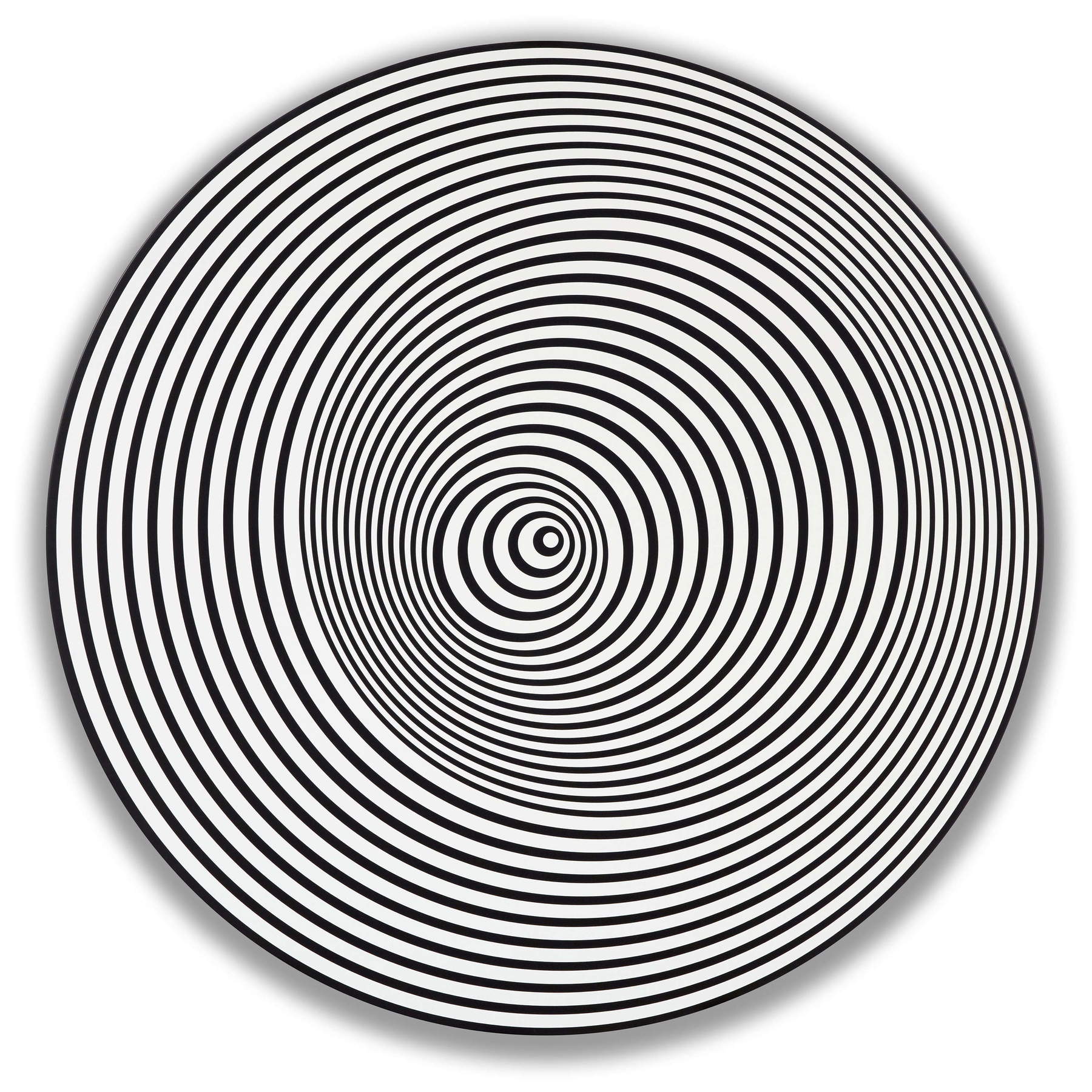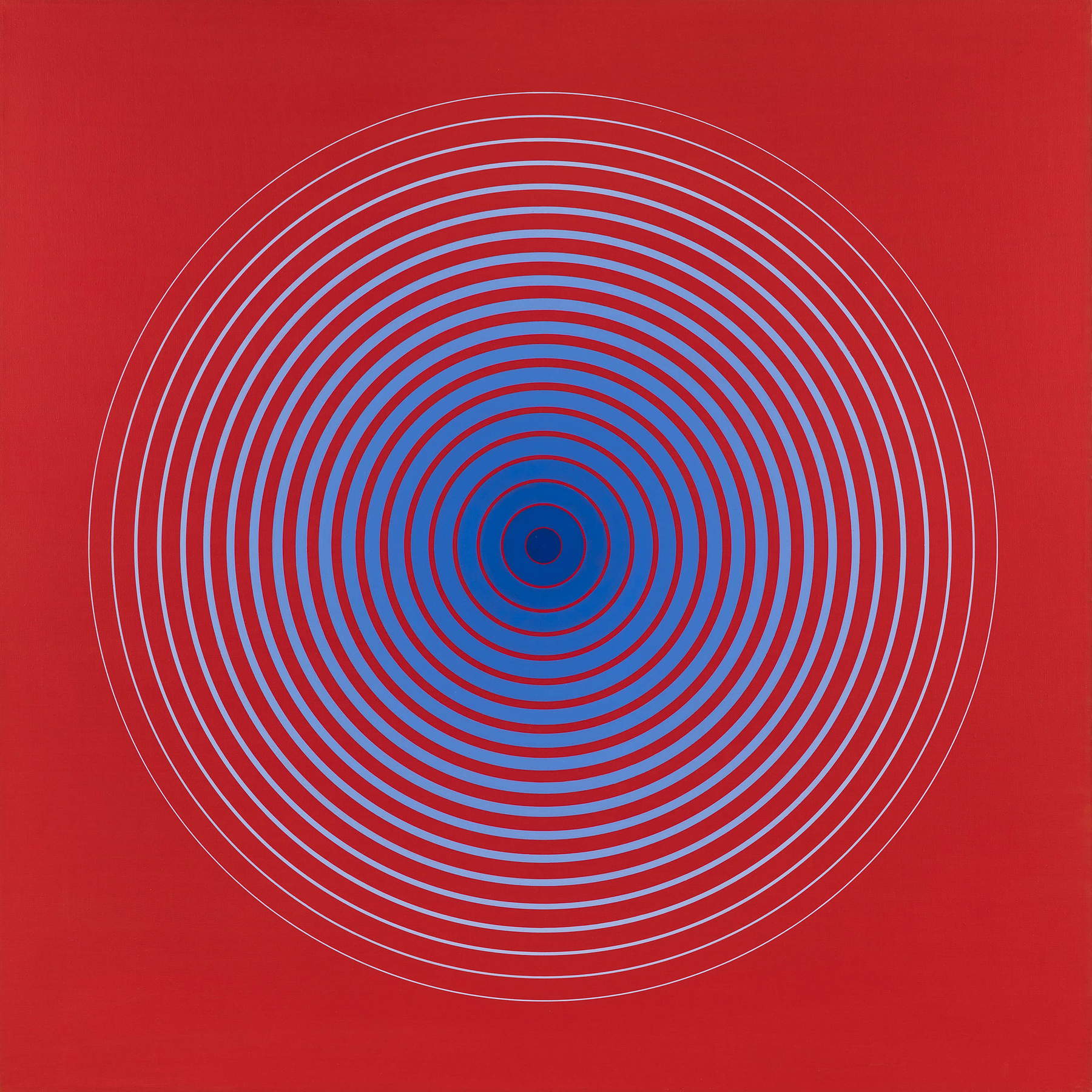Is there heat and eros behind op art? The case of Marina Apollonio
Behind the work of Marina Apollonio, a leading artist in internationaloptical and kinetic art, unimaginable hot urges stir. This is what Marianna Gelussi writes in her essay that opens the catalog of the exhibition Marina Apollonio. Beyond the Circle (Venice, Peggy Guggenheim Collection, Oct. 12, 2024 to March 3, 2025). Behind the Triestine artist’s works there is “body, magnetic attraction, drive, a kind of eros in which the viewer is a participant, drawn into an active relationship, perception enlarged, eyes and senses on the alert, consciousness heightened, a protagonist in the becoming of the work”: so writes Gelussi, taking up almost verbatim a remark by Arnauld Pierre on optical art in general.
We are indeed accustomed to looking at works ofoptical art with a certain detachment. A perception of coldness is usually associated with op art, mainly because of the way the works of the artists of this movement present themselves to the viewer. Rigid geometric shapes and repetitive patterns. Lines, circles, squares and other simple shapes to create complex compositions. An emphasis on geometry and symmetry that can give a sense of order and rationality, which contrasts with the emotionalism often associated with other currents. A visual language that tends to be perceived as “cold” because it communicates stability, control, precision. The absence of organic curves and fluid forms. And then, we talk about works that rely on optical illusions and visual effects created through the use of contrasts and repetitions: elements that lead us to believe that the art thus produced is more of an intellectual than an emotional experience. The viewer grasps an invitation to reflect and investigate the optical properties of the work, rather than connect to an immediate emotional experience. What’s more, optical artworks exclude personal narratives, stories, narratives, thus drawing a further distance between artist and audience.

But that is not all. Op art techniques can also increase this feeling of coldness. Art produced by more “industrial” or “mechanical” means, if you want to call them that, is often seen as less personal than art made by hand. When a work seems to derive more from a technical process than from individual expression, it can generate a sense of emotional distance. Marina Apollonio herself, for example, uses a variety of techniques to create her works, and this focus on processes can appear as a departure from direct human experience. Practices similar to those in graphic design, advertising, design. Industrial-like practices, art that seems to reflect a production environment rather than a personal artistic experience.
Is that all, in short? Is optical art, then, really so glacial? Are op artists after all scientists lent to art? Is it possible to find warmth even behind such rational, calculated, mathematical works? In order to seek answers to these questions, we need to consider the whole complexity of these works, to observe them in depth, not limit ourselves to the surface, to visual effects. Marina Apollonio’s works, meanwhile, are animated by a deep love of order that moves her plastic research on the basis of an accurate, precise, constant investigation of the possibilities of forms. “The elementary form,” the artist had written in 1966 on the occasion of her first solo exhibition, held at the Centro Arte Viva Feltrinelli in Trieste, “has in itself total abstraction in that it is constituted by a mathematical program. On this basis the action takes place with absolute rigor in a direct relationship between intuition and verification: intuition on an optical level and verification on a mathematical system. Having chosen a primary form, such as the circle, for example, I study its structural possibilities in order to make it active, seeking the maximum result with the maximum economy.” Marina Apollonio’s attitude has always been geared toward geometric research, but behind her geometric research, which began independently and without membership in any group, pulses an intense vitality, there is a deep emotional meaning linked to the desire to understand nature, to probe the reality in which we are immersed.
From the very beginning, his research has posed the problem of theinteraction between the work and the viewer. Circular Dynamics, Marina Apollonio’s first major series, begun in 1963, is composed of objects, circular in shape as the name of the series itself suggests, that aim to explore the structures and possibilities of activation of one of the most elementary and at the same time most fascinating forms: the circle. Not only that: in Circular Dynamics usually space is always structured according to patterns of concentric circles, of varying thickness and size, which almost create a sense of alienation in the viewer. From a very young age Marina Apollonio has posed the problem of the position of the viewer, who is called to actively interact with her work. When the viewer has before him a work by Marina Apollonio, it happens that the visual effects change, giving rise to a visual and sensory dialogue that is vital, involving, activating. And this dialogue is activated even where the objects are static ( Circular Dynamics can in fact be both static and dynamic), since they manage to act on the audience simply by leveraging their structure, becoming, like the dynamic works, vital objects. Precisely by virtue of the effects they produce on the viewer, “the circular connections of these works, which depend on a strictly programmed approach governed by mathematics,” observes the aforementioned Arnauld Pierre, “fall into a baroque mode of visual research that escapes the demonstrative dryness of psychological tests. With them, one enters a universe of formal refinements that no theory had foreseen and that emphasize the specific role of artists and plastic research in the augmentation of the visual universe-a task that, a priori, scientists do not attribute to themselves, probably because they do not need to, although they may be impressed by the problems posed by the new visual equations defined by artists.”



The Circular Dynamics were black and white objects: with the Gradations, “circular visual chromatic units,” as Apollonio herself called them, painted between the mid-1960s and early 1970s, programming for the first time acts on color, through gradual variations always set on concentric circle structures, following the lesson of Josef Albers: the juxtapositions between different hues end up altering colors by generating in the viewer the perception of chromatics that, in reality, are nonexistent: it is the juxtaposition that produces a sensation of aura that conditions the viewer’s response to the point of even generating emotions, energy. Color, it is well known, has the ability to activate sensations and associations on an unconscious level, and consequently even in a context of geometry and formal rigor it can instill a sense of warmth and drive, can lead to visual experiences that touch the heart and soul, suggesting an emotional intensity that defies the perceived coldness of optical art. “In displacement,” Gelussi writes, “the monochrome white of frontal vision is transformed, circles come to life unexpectedly revealing a minimalist colored line or a rainbow of colors, with an instant effect of pure wonder.”
Apollonio’s works can also be interpreted as a reflection on human relationships. Although the op art aesthetic is based on geometric and optical principles, what emerges is often a sense of connection and interaction. Forms can be seen as metaphors for relational dynamics: repetitive patterns can allude to shared rhythms of life, collective experiences, and emotional connections. Here then, Apollonio’s art also becomes an exploration of human experiences and the drives that unite us. The circle, in this sense, a universal symbol, becomes a kind of bridge between abstraction and reality, between universal and particular, between nature and culture.




There is an inherent tension between the rationality of geometry and the emotional drive. Marina Apollonio has often sought to explore and overcome this dichotomy. Her art is not only an expression of mathematical rules, but also a way to investigate the depths of human perception and emotional experience. Also through mathematical laws. If art, taking up a very ancient formula, is imitation of nature, op art is imitation of the laws that govern nature. Apollonio has never hidden that she was attracted to form from childhood, simply observing what was around her. “The profile of a snail, the structure of a leaf, the rings of a cut tree trunk, the texture of a nest, the spiral of a pea plant.” In Marina Apollonio’s vision everything has a form. A form that can be observed, that can be studied, a form that presents itself as a constant and from which therefore an abstract formula based on mathematical proportions can be derived.
Apollonio’s art invites the viewer to explore not only the visual properties of the works, but also the emotional and sensual depths that can emerge from an apparently abstract work. His works are reflective of a connection between art and nature. In this sense, it is permissible to find some form of eroticism behind his works. Works to be read not only as elements of a visual game: they are also an exploration of human experience, desire, and freedom.
Warning: the translation into English of the original Italian article was created using automatic tools. We undertake to review all articles, but we do not guarantee the total absence of inaccuracies in the translation due to the program. You can find the original by clicking on the ITA button. If you find any mistake,please contact us.



























